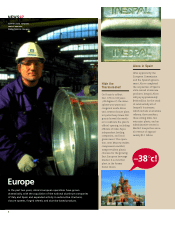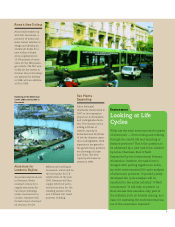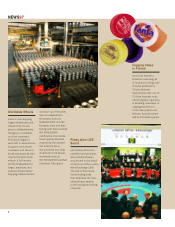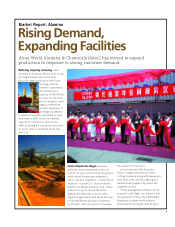Alcoa 1997 Annual Report Download - page 18
Download and view the complete annual report
Please find page 18 of the 1997 Alcoa annual report below. You can navigate through the pages in the report by either clicking on the pages listed below, or by using the keyword search tool below to find specific information within the annual report.
NEWS97
16
Market Report: Automotive
Here Come the
Aluminum Cars!
Aluminumusage in automobiles and
lighttrucks has been climbing steadily.
Even more important, auto
manufacturers are beginning to
see aluminum the way aircraft
manufacturers do — as the basic
structural material for their vehicles.
Increasingly, in the case of car-
makers, that thinking begins with
an aluminum body structure such
as the spaceframe.
It’s a new and potentially powerful
trend, and Alcoa has played a major role
in getting it started. As recently as 1990,
there were no aluminum-structured pas-
senger cars in production anywhere in
the world. The closest thing was the
HMMV (Hummer), at that time strictly a
military vehicle.
As of 1997, there were seven alu-
minum-structured passenger cars in
production. For three of them — Audi A8,
Plymouth Prowler, and GM EV-1 —Alcoa
has been the principal partner in
designing, engineering and manufacturing
aluminum components, subassemblies,
and — in the case of the Prowler —
the frame itself.
And that’s just the
beginning. Alcoa
Automotive Structures
(AAS) is currently working with a dozen
automakers on aluminum car projects
that have significant promise. Those can’t
be discussed right now, but here are a few
other developments that can.
A concept car with a modular
spaceframe. In technology reviews held
for Ford and Chrysler, Alcoa unveiled a
vehicle concept embodying ideas for
future cars and light trucks. The design is
based on a spaceframe structure compa-
rable to those Alcoa has helped to devel-
op for the Audi A8 and Plymouth Prowler.
But in the concept vehicle, the space-
frame is modular — a step toward using
such structures in a broad range of
future vehicles. By changing modules, a
carmaker could produce a sedan, a sport
utility vehicle, and a pickup truck, all
from a single production platform.
New programs with Daimler-Benz
and Chrysler. Alcoa is producing the
front energy management structure
for the new Mercedes-Benz A-class car
(above) now selling in Europe. This
11-piece structure was designed by Alcoa
and is robotically assembled at Alcoa’s
plant in Soest, Germany. Production volume
is expected to reach 1,000 units per day.
For Chrysler, an aluminum rear cross-
member designed and manufactured by
Alcoa improves the handling and noise-
vibration-harshness performance of the
all-new 1998 Dodge Intrepid and Chrysler
Concorde as well as the 1999 Chrysler LHS
and 300M models. AAS will manufacture
270,000 units per year at its Northwood,
Ohio plant.
Something new around the
windshield. A key advance incorporated
in the 1997 Corvette is a first-of-its-kind
windshield surround developed in
a design and engineering collaboration
of General Motors and Alcoa. An effective
combination of aluminum cast and
extruded products makes this an
extremely stiff structure, helping the
new Corvette to earn excellent reviews
for its stiffness and superior handling.
Northwood will produce 25,000 wind-
shield surrounds annually.
Explosive demand for aluminum
drive shafts. Aluminum drive shafts for
rear wheel drive cars, light trucks, and
sport utility vehicles showed strong
growth in 1997. Alcoa Engineered
Products was challenged by its customers
— Ford, General Motors, Chrysler, Jaguar,
and Isuzu — to increase capacity.
Using the tools of their new Alcoa
Production System, workers at Lafayette
Operations achieved sharp reductions in
changeover and cycle times, raising
monthly production by 70%. Further
gains are in the works.
Design tools to aid in product
development. New guidelines for use
in designing automotive components
have been installed at AAS operations in
Esslingen, Germany; Southfield, Mich;
and Alcoa Technical Center (ATC) near
Pittsburgh. Developed by AAS and ATC,
the guidelines will assist automotive
engineers in evaluating product design
and fabrication options. Objectives:
Improve design quality and cut develop-
ment time by 30%.
©1997 GM Archives
























